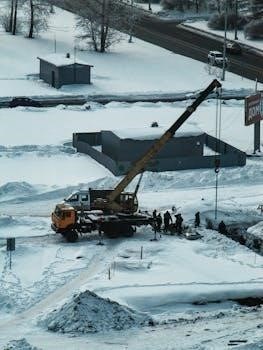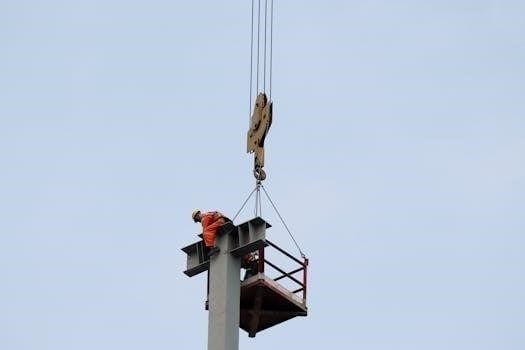crane manual
Crane Manual Overview
Crane manuals are essential for safe operation and maintenance, providing crucial information. These manuals include safety protocols, operating instructions, and maintenance schedules. They guide operators and service personnel, ensuring safe usage and proper upkeep of cranes.
Crane manuals are comprehensive documents that serve as the primary resource for information regarding specific crane models. These manuals encompass a variety of critical details, including safety guidelines, operational procedures, maintenance schedules, and troubleshooting instructions. They are essential for anyone involved in the operation, maintenance, or installation of a crane. Each manual is tailored to a specific crane model, ensuring that the information is accurate and relevant. Crane manuals are not merely instruction books; they are vital safety documents that promote a secure working environment. They often contain detailed diagrams, charts, and specifications that aid in proper usage and prevent accidents. The importance of consulting these manuals cannot be overstated; they are fundamental to ensuring the longevity and safety of crane operations. Properly utilizing these guides helps to keep everyone safe and makes sure operations are effective.
Importance of Manuals for Safe Operation
Crane manuals are indispensable for ensuring safe crane operation, providing crucial information that helps prevent accidents and injuries. These documents outline precise procedures for operating specific crane models, detailing safe lifting capacities, proper rigging techniques, and emergency protocols. They also contain critical information on pre-operation checks, helping operators identify potential issues before they become hazards. The manuals emphasize the importance of regular inspections and maintenance, guiding users through the necessary procedures to keep equipment in good condition. By adhering to the guidelines, crane operators can minimize risks associated with crane operation and ensure their safety and the safety of others on the job site. Furthermore, these manuals often include safety warnings and precautions that are essential for preventing damage to the equipment and the surroundings. Crane manuals are the foundation of safe crane operations.

Crane Operation Guidelines
Operating cranes safely requires adherence to strict guidelines. These encompass operator qualifications, pre-operation checks, and safe operating procedures. Power line safety is also a critical aspect of these guidelines.
Operator Qualifications and Responsibilities
Crane operators must meet specific qualifications, often outlined by standards like ANSI B30.5 and OSHA 29 CFR 1926 Subpart CC. These qualifications ensure operators possess the necessary skills and knowledge for safe crane operation. A competent operator is paramount for preventing accidents and ensuring the mechanical soundness of the crane. Operators are responsible for understanding the crane’s capabilities and limitations, never exceeding its maximum rated capacity. They must also be proficient in conducting pre-operation inspections and identifying potential hazards. Furthermore, operators are accountable for adhering to all safety protocols and operating procedures. Their responsibilities include immediately reporting any concerns about the crane’s safe operating condition to maintenance personnel. Crane operators must always prioritize safety. The operators must ensure safe operation, and be familiar with the crane’s specific manual. They should be aware that their role is vital to the safe operation of the crane, and should be well-trained to fulfill their duties. Proper training and certification are crucial for all crane operators.
Pre-Operation Checks and Inspections
Before operating a crane, thorough pre-operation checks and inspections are crucial. These checks ensure the crane is in safe working condition and help prevent accidents. Operators must visually inspect all units for integrity, leaks, and any signs of damage or wear. They should check the operation of the crane, including controls and movements, to ensure they function correctly. It is important to verify the crane is not overloaded and the load is within the crane’s capacity. Inspecting crane components according to the manual’s recommendations is essential. These inspections should be performed at the start of each shift, ensuring all safety systems are functional. Operators must ensure that the crane’s load charts and safety devices are operational. The crane’s mechanical soundness must be verified before any operation takes place. Checking safety mechanisms such as brakes and limit switches should be included in the pre-operation checklist. These routine checks play a vital role in the safe operation of the crane. If any issues are found during these inspections, the crane must not be used until repairs are made.
Safe Operating Procedures
Safe operating procedures are essential for preventing accidents and ensuring efficient crane operation. Operators must adhere to the crane’s rated capacity and avoid overloading. They should follow the specific instructions provided in the manual for the crane model. It is important to use proper rigging techniques to secure loads correctly. Operators should operate the crane smoothly and avoid sudden movements. Maintaining awareness of the surroundings and other personnel is critical to prevent accidents. The operator must ensure that the load is stable during lifting and movement. They must also avoid operating the crane in adverse weather conditions if not recommended by the manual. Operators must operate empty hook to check the functionality before any load. Communication with ground personnel is essential, using hand signals or radios. If the operator is unsure about the task, they should seek clarification before proceeding. Always refer to the crane manual for safe operating practices and guidelines. It is critical to use the crane only in the conditions specified by the manufacturer.
Power Line Safety
Power line safety is of utmost importance when operating a crane. Always maintain a safe distance from power lines, as specified by OSHA regulations. Consult the crane manual for specific clearance requirements. Electrocution is a major hazard, so never operate a crane near energized power lines. The operator should be aware of the location of overhead lines before beginning any work. A spotter should be used to monitor the crane’s position relative to power lines. Cranes can contact power lines when raising or lowering the boom, or when moving with a load. If the crane comes into contact with a power line, the operator should stay inside the cab and wait for assistance. Workers on the ground should not touch the crane or the load. Never assume power lines are de-energized, treat all lines as if they are live. Always follow the crane’s operating manual’s guidance and safety protocols. It is crucial to have a safety plan in place that includes power line hazards. Ensure proper training for all personnel involved in crane operations regarding power line safety.

Crane Maintenance and Safety
Regular maintenance is vital for crane safety. Manuals detail schedules for inspections and component checks. Following safety protocols ensures safe operation. Proper upkeep prevents accidents and extends the crane’s lifespan.
Regular Maintenance Schedules
Establishing and adhering to regular maintenance schedules is paramount for ensuring the continued safe and efficient operation of cranes. These schedules, often detailed in the crane’s manual, outline the frequency of inspections and servicing required for various components. They typically include daily, weekly, monthly, and annual tasks, each designed to identify potential issues before they escalate into major problems. Daily checks might involve visual inspections for leaks, loose parts, or damage, while weekly checks may include lubrication of moving parts and verification of control functionality. Monthly checks often focus on more in-depth assessments, such as examining the crane’s structure for signs of wear and tear, and annual maintenance usually involves a comprehensive overhaul, including the replacement of worn components and thorough testing of safety systems. The manual specifies the exact intervals and procedures for each task, ensuring that all necessary checks are performed to maintain the crane’s integrity and operational safety. These schedules are not arbitrary but are based on the crane’s design, usage, and environmental conditions, and are crucial for preventing breakdowns and prolonging the life of the crane.
Inspection of Crane Components
Thorough inspection of crane components is a critical aspect of maintaining crane safety and operational readiness. Crane manuals detail the specific components that require regular inspection, along with the methods and criteria for evaluating their condition. These inspections typically involve checking the structural integrity of the boom, jib, and outriggers for cracks, bends, or corrosion. The condition of the wire ropes, chains, and hooks must be assessed for wear, damage, and proper lubrication, ensuring they can safely handle the loads. Moreover, the crane’s hydraulic system, including hoses, cylinders, and pumps, should be checked for leaks and proper functioning. The electrical components, such as wiring, control panels, and safety devices, require scrutiny to ensure they are in good working order and compliant with safety standards. The manual also often includes checklists and diagrams to guide these inspections, making sure no component is overlooked. This meticulous inspection regime helps identify potential issues early, enabling timely repairs and preventing equipment failures that could lead to accidents.
Crane Safety Protocols
Crane safety protocols are essential guidelines designed to prevent accidents and ensure the safe operation of cranes. These protocols, typically detailed in crane manuals, cover a wide range of procedures from pre-operation checks to emergency shutdown processes. They emphasize the importance of maintaining a safe working environment, including proper communication between crane operators, riggers, and ground personnel. Crane manuals often specify the need for regular safety meetings and hazard assessments to identify and mitigate potential risks. They provide instructions on proper signaling, load handling techniques, and restrictions on operating near power lines. Emergency procedures, such as how to respond to crane malfunctions or accidents, are also clearly outlined. Furthermore, these protocols usually mandate that only qualified and trained personnel are authorized to operate the crane and perform maintenance, ensuring a competent team is managing the equipment. Adherence to these protocols is crucial in preventing injuries, property damage, and ensuring the overall safety of the work site.

Crane Specific Information
This section details specific instructions for different crane models, including operation and installation guidance. These manuals are crucial for safe and efficient use of each crane, providing model-specific information.
Specific Crane Model Operation Instructions
Each crane model has unique operational requirements, detailed in its specific manual. These instructions cover everything from pre-start checks to shutdown procedures, tailored to the crane’s design. Operators must familiarize themselves with these specifics to ensure safe and efficient performance. For instance, a telescopic crane will have different operating procedures compared to a jib crane or a tower crane. The manual will outline the specific steps for starting the crane, controlling its movements, and safely lifting loads. It also includes information on the crane’s load capacity, operating speed, and range. These instructions will be specific to each crane model, and must be followed closely to prevent accidents. Furthermore, the manual will detail the proper use of control systems, safety devices, and emergency procedures. Therefore, strict adherence to these model-specific instructions is crucial for operator safety and crane longevity. Ignoring these instructions could result in equipment damage or serious injury.
Crane Installation Guidance
Proper crane installation is vital for safety and performance, with detailed guidance found in the crane’s manual. This section provides step-by-step instructions for assembling and setting up the crane at the work site. The manual specifies site preparation requirements, including ground stability and load-bearing capacity, that is fundamental for the crane’s safe operation. It also outlines the correct procedures for erecting the crane’s structure, like assembling the boom, jib, and outriggers. Furthermore, the guidance covers the proper connection of electrical and hydraulic systems, ensuring that all connections are secure and compliant with safety standards. For cantilever cranes, specific instructions on mounting and anchoring are provided. The manual emphasizes the importance of precise alignment and leveling, to avoid structural issues. It also provides information on counterweight placement and testing procedures. Therefore, adhering to these guidelines ensures the crane is stable and ready for safe operation. Ignoring these instructions could lead to equipment failure and hazardous working conditions.

Additional Manual Resources
Crane manuals and documentation can be accessed through various platforms, including manufacturer websites like Manitowoc. These resources offer reference materials for safe crane operation, maintenance, and specific model instructions. These are for reference only.
Accessing Crane Manuals and Documentation
Crane manuals and related documentation are vital resources for safe and efficient operation. These materials are often available from multiple sources, including the crane manufacturer’s website, such as Manitowoc. These online resources typically provide downloadable PDF versions of operation manuals, safety handbooks, and maintenance guides. It’s important to note that manuals on websites are often for reference only, and the serial-number-specific manuals provided with the crane should always take precedence.
Additionally, physical copies of manuals are usually included with the crane upon purchase. Operators must ensure they have access to these resources and have reviewed the relevant sections before operating a crane. These manuals provide essential information about the crane’s specific model, operation instructions, safety protocols, and maintenance schedules. Some organizations may also offer internal resources or training programs that incorporate crane manual information. Always consult the most up-to-date version of the manual for your specific crane model.
